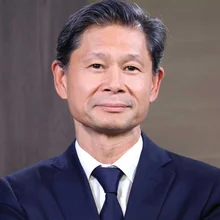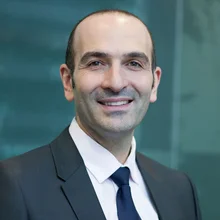
Interest rate derivatives house of the year: Societe Generale
Risk Awards 2018: Structuring smarts help French bank grow in slow rates market

For the big beasts of the interest rate derivatives market – Citi, Goldman Sachs, JP Morgan – strategy is relatively simple; executing it is the challenge.
For everyone else, the question is how to carve out a role that is sustainable and makes sense – a franchise you can defend, a platform from which you can grow. Over the past three years, Societe Generale Corporate & Investment Banking (SG CIB) has done that, parlaying structuring smarts into a role as a flow liquidity provider for some of the market’s biggest derivatives users.
The bank’s appetite has taken some of those customers by surprise.
“I give them a lot of credit,” says a source at one of the big US government-sponsored enterprises. “I had a bias. I didn’t walk in the door saying we need to get SG involved. They did a great job convincing a non-impartial counterparty that they really deserve to be in the mix. They’ve made a great effort over the past few years.”
A derivatives trader at one of the largest US life insurers sees it similarly: “For us, they’ve always been in the top five, but over the past few years they’ve pushed into the top tier.”
And the chief executive of one New York-based hedge fund praises what he sees as a strategically important relationship: “They educate clients about how regulatory changes affect markets, package derivatives products linked to those changes and help us take advantage of some of the market dislocations. They have been in front of the curve, and work with us closely, and that’s something we feel very appreciative of.”
One of the bank’s strengths has been its Asian structured business, which gives it a steady stream of semi-exotic and exotic positions it can offer cheaply to hedge fund and real-money investors in the US and Europe. With many investors moving up the sophistication scale in search of yield in recent years, these opportunities have helped put the French bank on the radar with many new customers.
For instance, in South Korea, the firm sells financial institutions a range of US rates-linked structured products such as steepeners, where investors take a view on the shape of the yield curve, and range accruals, where the payout is dependent on whether rates remain in a given corridor. This gives the bank a number of long-tenor digital risks that it recycles to pension funds, asset managers and hedge funds – at a discount – which are struggling to find yield in the current environment.

We have scrutinised all the asset classes and there is one very specific asset class on one specific segment or bucket where you can be long vol and be positive carry. This is very rare
Albert Loo, SG CIB
The bank has also been involved in Taiwan’s Formosa market since it opened to foreign issuers in 2014, having issued more than $4.5 billion of its own bonds in total, and acted as a hedge counterparty for local issuers.
Formosas are callable US dollar-denominated bonds, which if listed locally can be classed as a domestic bond. This gives issuers more access to Taiwanese insurance investors, given their international exposures are capped.
Issuers can lower their effective interest rate by entering a package trade – selling the fixed-rate risk and callability to rates desks in exchange for a floating rate. US mortgage agencies also issue callable bonds, and SG CIB has been a consistent hedging counterparty for one of the largest.
Together, this gives the bank’s rates desk a flow of US dollar swaptions risk to sell to insurers and pension funds for hedging purposes. SG CIB also used some of the flows to put hedge funds into relative value plays, where they were long the cheap Bermudan-style option that comes from the Formosas and short the more expensive European-style swaptions.
These flows enabled SG CIB to give US asset managers a profitable way to be long volatility. With realised equity volatility stubbornly low, firms trying to go long volatility are losing carry. SG CIB found rates was the only asset class where it was possible to go long volatility and have positive carry, thanks to the inverted volatility term structure caused by the Formosa selling.
“We have scrutinised all the asset classes and there is one very specific asset class on one specific segment or bucket where you can be long vol and be positive carry. This is very rare. And this is coming from the fact that there is significant pressure on volatility from the Asian flow in particular,” says Albert Loo, global head of sales for fixed income, currencies and cross-asset at SG CIB in Paris.

As more and more asset managers have become cross-asset and have tried to find opportunities between one asset class and the other, it has become a very simple way to play this trade
Thomas Decouvelaere, SG CIB
SG CIB put a number of US and European hedge funds and real-money firms into packages of cheap long-dated swaptions to take advantage of the structural dislocation. Loo says that with central banks likely to exit their quantitative easing strategies at some point, combined with the possibility that the Taiwanese regulator may restrict life insurers’ use of Formosas in the future, long-dated volatility is likely to rise, making the trade appealing to many investors.
The bank also brought its equity structuring technology into the rates business, offering clients variance swaps, in which investors pay the difference between realised and implied volatility.
“As more and more asset managers have become cross-asset and have tried to find opportunities between one asset class and the other, it has become a very simple way to play this trade,” says Thomas Decouvelaere, head of pricing for fixed income at SG CIB in London.
Over the past couple of years, these types of trades have given SG CIB a foot in the door with major rates players to sell other products such as plain vanilla interest rate swaps and cross-currency swaps.
It works the other way, too, where the firm has made an impression on the plain vanilla swap side and expanded client relationships to cover more complex products.
In electronic interest rate swap trading, SG CIB stormed up the Tradeweb rankings this year, going from a 1.4% market share by notional printed for US dollar interest rate swaps in June 2016, to a 9% share by November 2017, putting it in third position. It holds a similarly strong position in euro swap market-making as well.

When you mix the receivers and the payer, you tighten the bid-offer big time; you can have a click-and-trade bid-ask of, say, 0.15 basis points for €200 million notional
Jérôme Sabah, SG CIB
Jérôme Sabah, global head of rates sales at SG CIB in Paris puts the boost down to the deployment of a new fixed-income algorithm. The algo, first introduced in 2015 but upgraded last year, can adjust the bid-offer of different underlyings based on its own axes and those of the bank’s human traders.
“Say on a 10-year swap, my trader – the human – is better axed to receive, so he’s making a price. And say the algo is axed to pay. Then you have a market where you have two traders – one is the algo, one is the human – having different interests. So when you mix the receivers and the payer, you tighten the bid-offer big time; you can have a click-and-trade bid-ask of, say, 0.15 basis points for €200 million notional,” says Sabah.
In addition, a bank will typically quote the same amount on both sides of the trade. The algo, though, can add its axes to a human quote on the screens, meaning SG CIB could be offering to pay €100 million and receive for €400 million, for example.
The bank has also been active in the corporate space this year – in particular on deal-contingent trades, where dealers give hedges to companies to cover risks between the announcement and completion of a merger. If the deal falls through, the hedge is cancelled.
SG CIB landed a role in the group of banks providing interest rate swap deal-contingent hedges for British American Tobacco’s $49.4 billion acquisition of Reynolds. BAT was to finance the purchase in US dollar-denominated debt, exposing it to interest rate risk between announcement and closure, which in the meantime required a lengthy series of regulatory approvals around the world.

As it gets closer to bond issuance, it’s more effective to switch from a swap underlying into the underlying of the Treasury, which will be the exact instrument used for the bond pricing
Antoine Jacquemin, SG CIB
The bond pricing was linked to the US Treasury rate, making a Treasury lock – where the Treasury yield is used as the floating rate reference instead of the swap rate – theoretically the right option. However, the Treasury roll would push the floating rate too high, so the hedge was structured as a vanilla interest rate swap.
This brought in some basis risk between the swap rate and the US Treasury rate, so the hedge was restructured into the latter just over a week before the bond issuance, leaving the credit component as the only uncertainty for the issuance.
“As it gets closer to bond issuance, it’s more effective to switch from a swap underlying into the underlying of the Treasury, which will be the exact instrument used for the bond pricing,” says Antoine Jacquemin, global head of market risk advisory at SG CIB in London.
The bank also showed its flexibility by finding a way for corporates to reduce their credit charge through margining, while limiting the liquidity risk.
SG CIB implemented a credit support annex (CSA) with French retailer Rallye that capped the maximum amount of variation margin it would have to pay through the life of the trade.
“We wanted to reduce the credit charge, and did not want to enter a cash collateral agreement as it was not convenient,” says Franck Hattab, general manager of Rallye in Paris.
“The capped CSA was perfect for us. We just had to post a capped amount in case of a negative mark-to-market, and there were no adjustments on a daily basis, just on a six-month basis. It helped us to reduce the credit charge on the swaptions we traded with them this year, and was the first time we accepted posting cash collateral on a derivative transaction,” he adds.
Only users who have a paid subscription or are part of a corporate subscription are able to print or copy content.
To access these options, along with all other subscription benefits, please contact info@risk.net or view our subscription options here: http://subscriptions.risk.net/subscribe
You are currently unable to print this content. Please contact info@risk.net to find out more.
You are currently unable to copy this content. Please contact info@risk.net to find out more.
Copyright Infopro Digital Limited. All rights reserved.
As outlined in our terms and conditions, https://www.infopro-digital.com/terms-and-conditions/subscriptions/ (point 2.4), printing is limited to a single copy.
If you would like to purchase additional rights please email info@risk.net
Copyright Infopro Digital Limited. All rights reserved.
You may share this content using our article tools. As outlined in our terms and conditions, https://www.infopro-digital.com/terms-and-conditions/subscriptions/ (clause 2.4), an Authorised User may only make one copy of the materials for their own personal use. You must also comply with the restrictions in clause 2.5.
If you would like to purchase additional rights please email info@risk.net
More on Awards
Trading systems: structured products/cross-asset – Murex
Murex won the Trading systems: structured products/cross-asset award at the 2025 Risk Markets Technology Awards for its MX.3 platform, praised for its flexibility and advanced analytics
Best vendor for system support and implementation: Murex
Murex has won the Best vendor for system support and implementation at the Risk Markets Technology Awards, recognised for its innovative MX.3 platform, exceptional client support and seamless implementation services
FRTB-IMA product of the year: Murex
Murex wins FRTB-IMA product of the year for its advanced, scalable MX.3 platform enabling seamless regulatory compliance
Pricing and analytics: equities – Finastra
Finastra’s Sophis platform wins the Risk Markets Technology Award for Pricing and analytics in equities, recognised for its robust capabilities in equities and derivatives trading
Best execution product of the year: Tradefeedr
Tradefeedr won Best execution product of the year for its API platform, which standardises and streamlines FX trading data, enabling better performance analysis and collaboration across financial institutions
Collateral management and optimisation product of the year: LSEG Post Trade
LSEG Post Trade wins Collateral management and optimisation product of the year for interconnected services that help mitigate counterparty risk and optimise capital usage
Clearing house of the year: LCH
Risk Awards 2025: LCH outshines rivals in its commitment to innovation and co-operation with clearing members
Driving innovation in risk management and technology
ActiveViam secured three major wins at the Risk Markets Technology Awards 2025 through its commitment to innovation in risk management and technology







